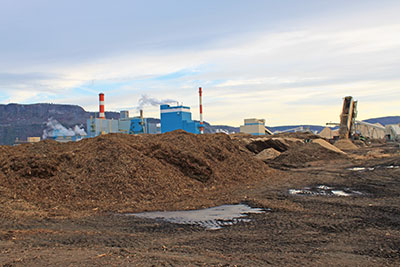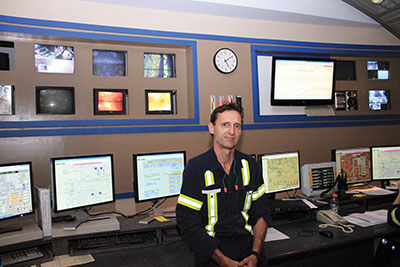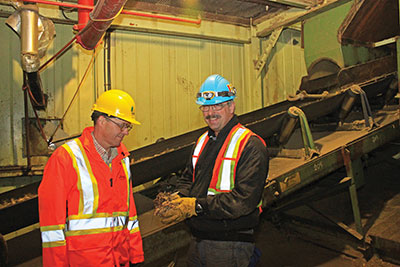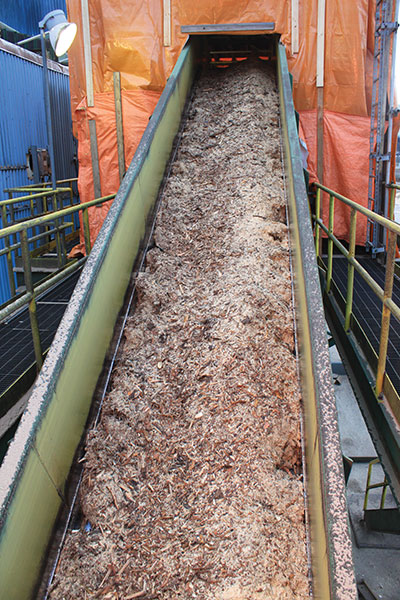
From paper to power
March 24, 2014
By
Amie Silverwood
Resolute Forest Products is a giant in the forest industry. They’re based out of Montreal with operations all over eastern Canada and pulp and paper mills in the U.S. and South Korea.
Resolute Forest Products is a giant in the forest industry. They’re based out of Montreal with operations all over eastern Canada and pulp and paper mills in the U.S. and South Korea. Recently, the company has installed a condensing turbine at its paper mill in Thunder Bay, Ontario to generate electricity from biomass to sell back onto the grid. Canadian Biomass had the opportunity to tour the paper mill in order to find out how power generation has fit into the company’s operations.
 |
|
| A truck filled with chipper debris is unloaded in the biomass storage area.
|
Resolute’s Thunder Bay Pulp and Paper mill is one of the three top complexes of its kind in Canada. It produces 566,000 metric tons of market pulp, newsprint and commercial printing papers and it also sells power from biomass. There are two biomass boilers in the mill with the capacity to generate 116 megawatts of electricity.
“It’s not a stand alone operation,” explained Terry Skiffington, the manager of the Thunder Bay Pulp and Paper mill, “we burn bark, make steam and make power but the operation of this facility is completely interconnected in terms of our overall steam and power systems in the mill. So that turbine goes up and down all day long, regulating and balancing the whole steam system in the mill.”
Not only is the biomass boiler integrated into the pulp and paper mill operations, the biomass burned at the facility supports local loggers and sawmills to make the whole company, and the region’s forest industry, more profitable. Resolute manages over 5 million hectares of forestland in Northwestern Ontario, 100 per cent of which are third party certified .Ontario operations are headquartered in Thunder Bay with plans to upgrade and restart the Ignace sawmill, construct a new sawmill in Atikokan and a new pellet production plant as part of the Thunder Bay Sawmill. Residue from the company’s managed forests and sawmills feed the boiler that powers the pulp and paper mill and sells power back onto the grid.
“In Thunder Bay, we have some tremendous advantages in terms of location and the forest that we have,” Skiffington asserted, “the boreal forest is the best forest for the pulp and paper industry and we’re relatively south but still actively working in and using the boreal. It gives us tremendous advantages in our costs and it’s a great place to play.”
The biomass boilers are fed sawdust, bark, and bush material from the company’s logging operations and sawmill and also the dead bacteria from the papermaking process. The chips are brought into the pulp and paper mill from the sawmill and the forest and they get screened to remove any pins, slivers and fines. The rejected material that can’t be used for making paper gets collected as biomass for the boilers. Sawmill residuals (bark and sawdust) get collected from the company’s sawmill. Chipper debris and logging slash is brought in from the company’s logging operations by the truckload.
The mill currently has a core supply of six contractors who run grinders and send 35 trucks a day to the yard, five days a week to collect about 200,000 tonnes a year from the sustainable forest licences and almost 100, 000 tonnes from private land. The boilers consume about 700, 000 metric tonnes a year of green biomass.
“The U.S. housing market recovery means there has to be a home for biomass because as the sawmills spin up, the biomass [from the sawmills] has to go somewhere and the best thing to do is to make energy with it,” said Skiffington.
 |
|
| Dwayne Tankula, one of the engineers that monitors the boiler takes a break to explain the equipment. “This boiler has been burning biomass since 1976 so we have some experience in burning biomass,” he said.
|
A healthy regional forest industry requires a balance that has to be maintained in order for operations to be profitable. The market demands lumber from the sawmills but if the sawmills can’t sell chips or sawdust, they can’t compete over time with other sawmills that have a healthier ecosystem with customers for their leftovers.
“It’s very important that this [pulp and paper] mill and other key mills in Ontario are in a position where they can be completing that balance otherwise, sawmills can’t run.”
Approximately half of the volume of wood that goes into a sawmill comes out as chips. In Northwestern Ontario, the industry is in a balanced state where all the sawmills have customers to buy their chips. Installing a condensing turbine that also consumes some of the leftovers from sawmills helps to maintain this balance and gives the company the confidence to build more sawmills in the region (in Atikokan and Ignace).
The biomass is delivered in trucks from within 200 kilometres of the mill from Monday to Friday. It’s brought onto the site and dumped into piles that are constantly being turned over to keep them from overheating and causing a fire. Sawdust is mixed with bark and chipper debris to come up with the perfect mix to fuel the fire. Sawdust alone is too combustible to be put in the boiler; it would be like throwing gasoline on a fire.
“We have sawdust that is 42 per cent moisture and then we have other material that is 52 and when we mix it all in together, we get a good product. The boiler is designed to burn biomass at 50 per cent moisture. So as long as we’re in the 46 to 48 per cent moisture, that’s where we want to be,” says Martin Kaiser, Fiber Optimization Manager for the Ontario operations.
Resolute has always burned biomass at the pulp and paper mill. From 1976 to 1997, it burned bark from the local sawmills but it was very homogenous compared to the material that is currently being burned. The sawmills liked to have the residue burned to avoid sending it to landfills and the pulp and paper mill liked the cheaper fuel. But in 1997, so many of the sawmills shut down and all of a sudden, there was nothing to feed the boiler.
 |
|
| Paul DeGiacomo and Martin Kaiser examine the biomass mix as it heads into the boiler on a conveyor belt.
|
The company took the opportunity to install a condensing turbine that would increase it’s biomass demand and started bringing in different products from the local forest: slash, tops and limbs ground up, chipper debris and ground full-tree birch. This new biomass brought with it different characteristics when thrown into the boiler and required active management. Now there’s a crew whose objective is to keep the steam generation constant; perfecting the recipe that feeds the boiler does it.
The mixed fibre is brought into the mill on a conveyer belt where it is combined with the sludge from the pulp and paper mill. Whatever isn’t used in the boiler comes back out and gets pushed back onto the conveyer to make another trip through. The fibre is fed into the boiler where it burns throughout the boiler on different levels: the sawdust will burn in the air while the heavier debris will fall to the bottom and burn more slowly.
“The biomass travels up the conveyor and drops into a spout” says Kaiser, “that distributes the biomass onto an inclined, vibrating, boiler grate. Air is injected into the boiler above and below the grate, and the material combusts as it moves down the inclined grate.”
It’s all managed from the control room that has cameras pointed at different parts of the boiler to monitor how much air is shot in, any bark buildup or other potential issues. Every aspect of the burn is monitored from the temperature to the energy produced. The end product is green power for the city and a well-balanced forestry sector in Northwestern Ontario.
The daily grind
Renewable Forest Products, RFP, is one of the first of the local contractors that has taken on the job of supplying chipper debris and logging slash for the boiler. Mario Letourneau, the owner of RFP, saw the benefit of adding a grinder to his operations immediately.
 |
|
| The biomass, a mix of sawdust, chipper debris and logging slash, is brought into the mill on a conveyor belt.
|
He explains his reasons for jumping into the business: “biomass is a byproduct of forestry so I think it is a nice addition to our business. It’s good for the environment and it’s a good utilization of the fibre. It’s one of the operations I like the most – it really works with our business.”
The logging contractors that take on this additional work are more productive. They’ve built the same amount of road and harvested the same amount of area but they’re able to use more of the fibre from the roadside so the volume they’re getting for their effort has increased.
Resolute to build a pellet plant
Resolute is building a pellet plant on the site of its Thunder Bay sawmill where it will produce 50,000 tonnes per year of pellets from the softwood sawdust and shavings from its sawmill. Forty-five thousand tonnes of the pellets produced will be shipped by bulk in a truck to the OPG Atikokan Generating Station.
Equipment was ordered at the end of 2013 for construction in the middle of this year. The company plans to begin commercial operation in the fourth quarter of 2014.
Print this page